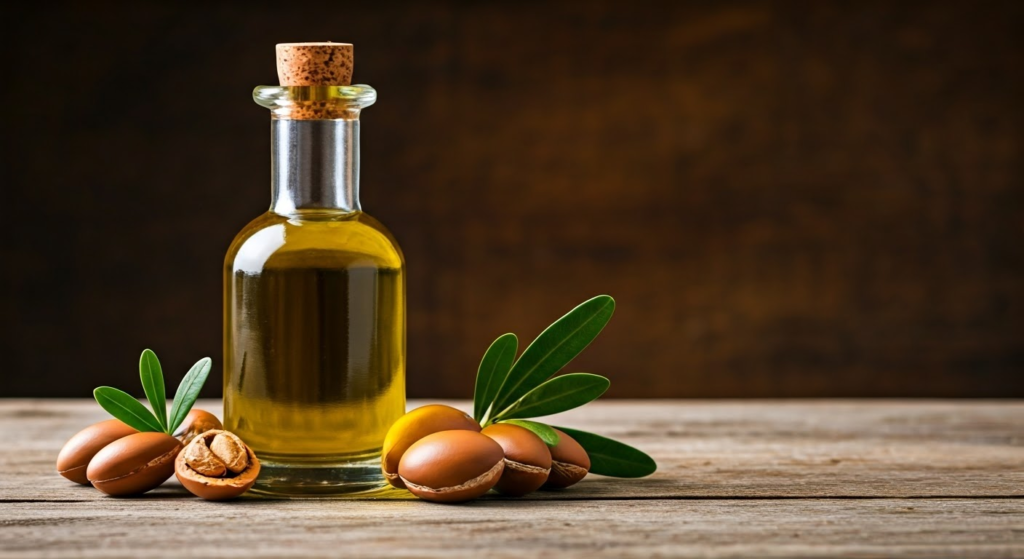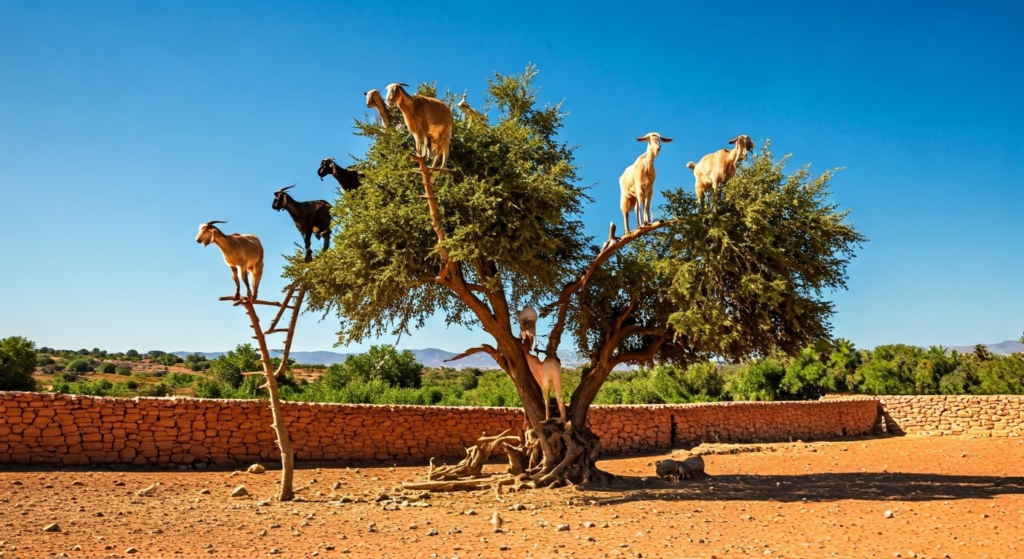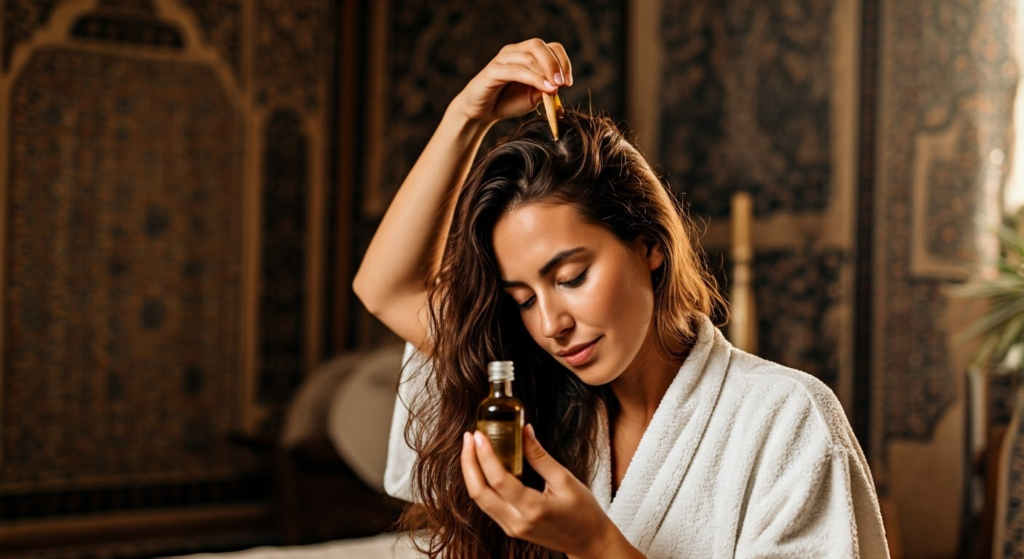A Tale of Berber Women, Old Customs & Where to Get an authentic Argan Oil

The First Time I Witnessed the Magic of Argan Oil
I still recall the first time I saw a Berber woman make Argan Oil by hand. It was at a small cooperative near Essaouira. The Atlantic breeze brought the nutty smell of roasted nuts. Her hands worked efficiently—cracking, grinding, and kneading—changing simple nuts into golden liquid.
“That’s why we name it Zit D’Argane,” she said with a smile, giving me a taste of fresh Amlou on warm bread. “Every drop carries our history from many generations.”
This is the story of Morocco’s best oil. It is a tale of tradition and the amazing women who continue this old practice.
The Argan Tree: Morocco’s Desert Survivor
A Tree That Defies the Odds
In Morocco’s dry southwest, where the ground breaks under the heat, the Argan tree (Argania spinosa) stands tall. Its twisted branches reach for the sky, and its roots go deep to find water where it is scarce. These trees do not just live—they grow well, making a full ecosystem in the Souss Valley.
UNESCO-Protected & Goat-Climbed
You have seen the pictures: goats sitting like acrobats in Argan trees. Locals joke that these goats are “the first harvesters.” They eat the fruit and spit out the nuts, making it easier to collect them. Beyond these popular images, UNESCO designated Morocco’s argan forests as a Biosphere Reserve in 1998. This protects the trees and the traditional practices associated with them.

From Fruit to Oil: A Labor of Love
1. Harvesting – A Race Against Time
From June to August, Berber women gather fallen Argan fruits before the hot sun can dry them up. I helped with the harvest once, and I can say—those sharp shells are cold!
2. The Art of Cracking – A Skill Passed Down Through Generations
In my childhood, I saw women sitting in circles and cracking each nut between two stones, making a rhythmic tap-tap-tap sound. It was really hard work as it takes 30 kg of fruit and about 2.5 days of work to make just 1 liter of oil. When I tried it, I broke half the kernels. The women laughed and said, “This is why we don’t let tourists do it!”
3. Roasting – Where the Magic Begins
If you want to use it as cooking oil, you will smell a rich, nutty smell that fills the kitchen after roasting the kernels gently over clay ovens. On the other hand, beauty oil does not go through this step, keeping its smooth, golden look.
4. The Final Press – By Hand or Stone Mill
In remote villages, women still make the paste by hand. They knead it for hours until the oil comes out. Bigger cooperatives use machines, but many believe the traditional way creates better quality.
How to Get the Most from Argan Oil
I want to tell you that Argan Oil is very useful, especially for women. You can use it in many ways to help your skin and hair.
You can use it as a moisturiser by taking a few drops and applying them to your skin after a shower. It helps keep your skin hydrated and nourished. You can also use it as a serum for extra care. It is good for treating dry cuticles and can work as a natural lip balm.
For hair care, apply Argan oil to damp hair as a leave-in conditioner. It helps control frizz, adds shine, and strengthens the roots. It is easy: just put a good amount of oil on your hair and scalp at night. Wash it out in the morning for soft, easy-to-manage hair.
In addition, I advise you to use it directly by mixing it into homemade beauty products. For more hydration, you can add it to facial masks, scrubs, or hair masks.
Why Real Argan Oil Costs a Fortune
- Exclusive to Morocco – The Argan tree grows only in Morocco.
- Hard Work – Producing 1 liter takes over 20 hours of hard work.
- Women’s Cooperatives – Many are fair-trade, making sure artisans get fair pay.
- Fake Oils in the Market – Sellers often mix it with cheaper oils in shops. Always buy from certified cooperatives!
How to Spot Authentic Argan Oil
- Check the Ingredients – The label should say 100% Argania Spinosa Kernel Oil with no extra stuff.
- Texture & Smell – Real Argan oil sinks quickly and has a light nutty smell or a mild, earthy scent.
- Packaging – Always buy oil in dark glass bottles. Plastic can harm its quality.
- Price – It could be fake or watered down if it’s cheap. Real oil costs about $20-$30 per 100ml.
How Moroccans Use Argan Oil (Beyond Beauty)
In the Kitchen
- Amlou – A tasty blend of Argan oil, crushed almonds, and honey, enjoyed with bread in the morning.
- Drizzled over couscous – Gives a nice nutty flavor to Friday family dinners.
- Salads & fish tagines – A special addition in coastal towns like Essaouira.
Home Remedies
My grandmother swore by it for:
- Healing burns and scars.
- Massaging sore joints with warm black soap.
- Boosting immunity with a teaspoon every morning.

Where to Experience Argan Oil in Morocco
1. Best Cooperatives to Visit
- Femmes du Maroc (Essaouira) – See how they make fresh Amlou and feel free to taste it.
- Cooperative Amal (Near Agadir) – Helps single mothers and women from the countryside.
- Tamounte Cooperative (Taroudant) – Not very touristy, really genuine.
Pro Tip: Avoid roadside stops that offer “free demonstrations.” These are usually tricks to sell you something.
2. How to Get There
- From Marrakech: You can rent a car for about 3.5 hours or take a CTM bus to Essaouira for $10.
- From Agadir: Grand taxis go regularly to cooperatives, but make sure to negotiate the prices!
3. Where to Stay
- Essaouira: Riad Mimouna is charming and affordable. Heure Bleue offers luxury.
- Agadir: Taghazout Bay is great for surfing and enjoying Argan products.
A Final Thought: More Than an Oil, a Legacy
Whenever I use Argan oil, I remember Fatima from the cooperative close to my hometown. Her hands, worn from years of pressing nuts, show a tradition that won’t disappear. This “liquid gold” isn’t just a product; it’s the central part of Morocco’s southwest, a sign of the strength of the Berber people.
So when you buy a bottle, look for the “Cooperative” label. You’re not just getting oil; you’re protecting a story.
Have you tried real Argan oil? How was your experience? Leave a comment below!
For more Moroccan secrets, like hidden camps in the Sahara and the best places for mint tea, follow my journey as a local storyteller! 🌍✨ #MoroccoWithALocal
